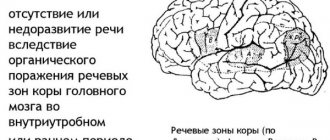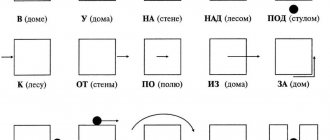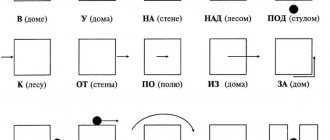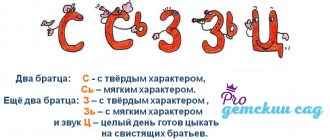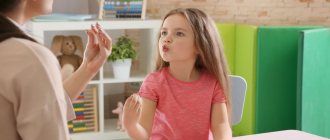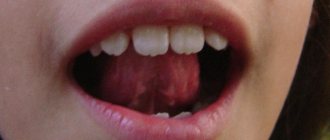1) automation of sound in syllables (direct, reverse, with a combination of consonants);
2) automation of sound in words (at the beginning of the word, middle, end);
3) automation of sound in sentences;
4) automation of sound in pure sayings and poetry;
5) automation of sound in short and then long stories;
6) automation of sound in spoken language.
The lexical material selected by the speech therapist to automate sounds (as well as for differentiation) must meet special phonetic requirements. First of all, it should contain the maximum number of sounds that can be fixed. At the same time, there should be no sounds that the child pronounces incorrectly, i.e., those that he has not yet mastered. Otherwise, he will develop incorrect pronunciation.
In addition, it is necessary to take into account the semantic accessibility of lexical material.
The speech therapist should also strive to ensure that, in the process of working on the automation of any sound, semantic speech material prevails over purely syllabic exercises.
A necessary condition for the fastest automation of sound is a gradual and systematic increase in the tempo of speech exercises. From a leisurely, exaggerated pronunciation of syllables, the child should gradually move on to a faster pronunciation of words, then to an even more accelerated pronunciation of sentences and, finally, tongue twisters. Only in this case is the correct pronunciation of the given sound quickly and firmly established.
The requirement to adhere to strict consistency in work on sound automation involves a gradual complication of lexical material, a transition from simple types of speech activity to more complex ones - from elementary repetition of words with a speech therapist to naming objects, actions, descriptions of the simplest situations depicted in the picture, reproduction of poems from memory, pure tongue twisters, tongue twisters and further to retelling short stories, composing stories based on a series of pictures and, finally, to free verbal communication.
The question of the procedure for correcting incorrectly pronounced sounds deserves special attention. It is clear that when a child does not have the correct pronunciation of one or three sounds, there can be no talk of a special system. But, as is known, complex dyslalia is more common, in which a large number of phonemes belonging to different phonetic groups are impaired.
This order must first of all correspond to the didactic principle of sequential transition from easier to more difficult. It has been established that correcting deficiencies in the pronunciation of whistling consonants is much easier than that of hissing consonants. Therefore, if a child has defects in the pronunciation of both consonants, he should start by working on the sounds s, s', z, z', c.
Based on the same principle, they first work on setting the sound
l, and
only then
r.
Article on speech therapy on the topic “Automation of sounds: traditional and innovative technologies
Automation of sounds: traditional and innovative technologies
According to the traditional method, the sequential elimination of sound pronunciation disorders consists of several stages: preparatory, the formation of primary pronunciation skills and the stage of the formation of communicative skills.
Speech therapy work on automating correct pronunciation is one of the important components of the stage of formation of primary pronunciation skills, following the production (or correction) of sound. Consolidation of correct sound pronunciation is characterized by duration and considerable labor intensity, which is due to the need to inhibit the non-standard pronunciation habitual for the child with the transition to a new motor stereotype.
When automating, it is necessary to follow the principle from simple to complex, its strict sequence - from automating an isolated sound to fixing its pronunciation in the text, i.e. the gradual introduction of a given sound into syllables, words, sentences, texts and, ultimately, into independent speech.
Sound automation can be carried out using traditional and innovative methods. In relation to the pedagogical process, the concept of innovation means the introduction of new things into the goals, content, methods and forms of teaching and upbringing, the organization of joint activities of the teacher and the child. In pedagogy and speech therapy, “innovations” boldly declare themselves. New books and publications are coming out [1; 11, etc.].
According to Dr. ped. Sciences A.V. Khutorskoy [12], in pedagogical innovation one should distinguish between innovations and innovations. If by pedagogical innovation we mean a certain idea, method, then innovation (or innovation) in this case will be the process of introducing and mastering this innovation. The peculiarity of the innovation process is its cyclical nature; innovation goes through the following structure of stages: emergence, rapid growth in the fight against opponents, maturity, development, dissemination, saturation, routinization, crisis, finish [12]. The wording “innovative technologies” may also reflect new approaches to working to eliminate a particular disorder of oral or written speech, as well as software and hardware technologies that help the speech therapist in his work. Below we consider traditional and innovative technologies used in modern speech therapy regarding sound automation.
The initial automation of isolated sound is carried out in various onomatopoeic games with broad reliance on non-speech associations (sound [s] - the sound of water; sound [w] - the “song” of a snake; sound [z] - the “song” of a mosquito, etc.). It is not recommended to dwell on the isolated pronunciation of a sound for a long time, since the minimum pronunciation unit is not a sound, but a syllable, in which the pronunciation and sound of a given sound is influenced by the sounds adjacent to it (the phenomenon of coarticulation). At the same time, it is unacceptable to move to automation of sound in syllables prematurely, i.e. until you get the correct and stable isolated sound.
Features of sound automation in syllables depend on the characteristics of the sound being practiced according to the method of formation. Thus, according to the traditional method, it is proposed to automate fricative sounds in the following sequence: in forward syllables (sa, so, su, sy, se), reverse syllables (as, os, us, ys, is, es), syllables with intervocalic position of the consonant ( asa, osa, usa, isa, ysa), in syllables with a combination of consonants (sma, ska, sva, sta). Automation of stop and fricative sounds (affricates) begins with syllables of the first two types, i.e. from the inclusion of sound in reverse syllables (ats, ots, uts, yts, its), after which they move on to direct ones (tsa, tso, tsu, tsy, tse).
To automate the sound, the child either repeats the syllables after the speech therapist, or performs special exercises (for example, finishes the last syllable in the word after the speech therapist, relying on pictures: fox...sa, hair...sy, flask...sa, beads...sy).
When automating a sound in a syllable, it is advisable to develop the skills of phonemic analysis and synthesis. For this purpose, tasks are offered to determine the place of a sound in a syllable, the sequence and number of sounds in it, composing a syllable from these sounds, transforming a syllable by changing the location of sounds (ca - ac, co - os).
To automate the sound in words, words with sound combinations already practiced in syllables (sani, koSA, OkSAna) are initially suggested. The automated sound in words must occupy a different phonetic position - at the beginning of the word, at the end and in the middle (the only exception is the position of the voiced consonant at the end and middle of the word before the voiceless consonant, since in these cases deafening of the voiced sound occurs). The words offered as speech material gradually become more complex in terms of the number of syllables and their structure. First of all, words consisting of two straight syllables (tire) are practiced. Next, the number of syllables increases (machine) and finally words with consonant clusters are introduced. Subsequently, the child pronounces words in which the automated sound occurs more than once (chisel, panties).
The correct pronunciation of sounds in words is reinforced both in the process of repeating words with a speech therapist, and during special games and exercises. In parallel, the problems of developing phonemic analysis (simple and complex forms), synthesis, and representations using pictures and sound patterns of words are being solved. For example, the child is asked to name a number of object pictures and distribute them under the corresponding diagrams indicating the location of the sound being practiced in the word (at the beginning, middle, end); name the pictures and, highlighting the initial sound in each of the words, create a new word from them; independently select words containing the given sound.
At the stage of automating sounds in words, children develop inflection and word formation skills. This is facilitated by traditional exercises aimed at improving the skills of changing the number of nouns in the nominative (koSa - koSy, hat - caps, shaR - balls), genitive (koSa - many koS, hat - many hats, shaR - many balls) cases, the formation of relative adjectives (strawberry juice - strawberry juice, apple juice - apple juice).
Speech therapy work on automating sound in a phrase is carried out while strengthening the child’s pronunciation of sentences with words already practiced in the previous stages (Sonya is eating soup. The bag is on the bench). Subsequently, phrases containing new vocabulary are introduced. The work is carried out either by the child repeating the speech material presented by the speech therapist, or through exercises for him to compose sentences based on subject and plot pictures, questions from the speech therapist, reference words and sentence diagrams. This also creates conditions for the development of skills in language analysis and synthesis, i.e. the child determines the number and sequence of words in a sentence, the place of the specified word, composing phrases from words presented both in an unbroken and in a broken sequence, both in the correct and in the initial grammatical form.
It is recommended to start work on automating sound in text with small nursery rhymes and poems, since rhythmic text is more accessible for memorization and playback. In the future, correct pronunciation is fixed on the material of the prose text through the use of the following types of tasks: compiling a retelling with support (and then without it) for clarity in the form of plot pictures; compiling a story based on a series of plot pictures, one plot picture at a time; composing a story based on a given beginning, supporting words, on a given topic, etc. This kind of task, in addition to automating sounds, contributes to the implementation of tasks related to the development of skills in semantic programming and linguistic design of text, and the formation of speech communication in general.
The success of using traditional methods does not exclude the use of innovations.
Computer technologies are among the widespread new effective teaching tools. For a specialist, they represent an additional set of possibilities for correcting deviations in a child’s development. As many authors note, the use of computer technology makes it possible to optimize the pedagogical process, individualize the education of children with developmental disorders and significantly increase the efficiency of any activity [10]. The computer in speech therapy classes is not a goal, not a subject, but a means that activates correctional work.
Unfortunately, the release of the computer video phonator “Visible Speech” (Speechviewer) for working with stutterers, children with rhinolalia and dysarthria and the first block of computer programs “Delfa” (“Delfa-141” - serially “Phonema”, “Delfa-142”) for Work on the intonation-rhythm side of oral speech, syllable structure, correction of open rhinolalia, and consolidation of the correct pronunciation of individual sounds has now been stopped. The second block of the program is devoted to working on written speech. The script was written by speech therapist, Professor O.E. Gribova [5].
Programs have appeared that can also be purchased by individuals: the computer manual “Speech Development. Learning to Speak Correctly,” intended for speech development and teaching reading (authors G.O. Astvatsaturov, L.E. Shevchenko [2]); computer speech therapy program “Games for Tigers”, aimed at overcoming speech disorders due to dysarthria, dyslalia, rhinolalia, stuttering, as well as secondary speech disorders (author L.R. Lizunova [9]); educational game “Baba Yaga is learning to read”, which is a method of advanced reading “Baba Yaga, go there, I don’t know where...”, aimed at developing memory, observation, logical thinking, spatial imagination; for school-age children “Computer workshop for conducting speech therapy classes in elementary school” [4].
Speech therapy rhythms as a system of work did not appear now, of course. At the moment there is a huge number of innovative developments and publications. In addition to the most complete manuals that have become classics, G.A. Volkova and G.R. Shashkina, attract the attention of many books concerning the possibility of using logorhythmics for one or another speech disorder, in one or another age period (for example, manuals by E.S. Anishchenkova, R.L. Babushkina, M.Yu. Kartushina, O.A. Novikovskaya, T.S. Ovchinnikova, etc.). Of course, this is a mature, widespread innovation that is actively used in the correction of sound pronunciation.
One of the innovative, quite effective techniques in preschool and school pedagogy can be considered mnemonics, with the help of which children compose descriptive and creative collective stories, retell, and learn poems. This technique allows you to work on the development of all aspects of speech, as well as non-speech mental functions.
In recent years, in speech therapy there has been a noticeable increase in interest in the use of fairy tale therapy based on ready-made folk or original fairy tales with all the richness of language contained in them (“The Tale of the Merry Tongue”, “Tales of Letters”). Nowadays, such a phenomenon as logostories (speech therapy tales by O.I. Ivanovskaya), methods described in the books of T.D. are intensively developing. Zinkevich-Evstigneeva and T.M. Grabenko.
The use of bioenergoplastics is also interesting. The term itself is probably familiar to few, but most speech therapists, perhaps, purely intuitively use this technique in their work. The term has two meanings: on the one hand, these are lessons in body plasticity, on the other, friendly movements of the hand and tongue (the movements of the hands imitate the movements of parts of the articulatory apparatus). In speech therapy, naturally, the second interpretation has become more widespread when automating sounds.
Innovative technologies also include art and sand therapy techniques used in speech therapy classes. Each of them can become the topic of a separate study.
Thus, the process of introducing and mastering pedagogical innovations is in some cases at the stage of growth, in others - the greatest spread.
When selecting speech material at all stages of speech therapy work to automate correct sound pronunciation, you should be guided by the requirements set out below.
· Compliance with the ontogenetic principle, according to which words containing sounds of a later ontogenesis than the one being automated are excluded from speech material. This allows the child to focus only on the sound being practiced and prevents the creation of additional articulatory difficulties (they inevitably arise with defective pronunciation of these sounds).
· Exclusion of material containing sounds that are acoustically and articulatoryly close to the one being automated (for example, when fixing the pronunciation of the sound [s], it is unlawful to suggest words like drying, candle, cold, which include hissing sounds).
· Availability of verbal and visual material for a child of a given age to understand.
The ultimate goal of speech therapy work on sound automation is for the child to master the ability to correctly pronounce it in spontaneous speech. At this stage, the significant role of the child’s microsocial environment should be noted. Thus, adults need to monitor his speech and demand correct pronunciation of sounds, which will significantly increase the effectiveness of correctional speech therapy.
It is important to preserve both traditional approaches and develop new directions in speech therapy theory and practice, and also to remember that any innovation is not good in itself (“innovation for the sake of innovation”), but as a means, a method that serves a specific purpose. In this regard, the stages of its development and dissemination are very important, which precisely show the need and effectiveness of the new technology.
List of used and recommended literature
1. Akimenko V.M. New speech therapy technologies. Rostov n/d., 2008.
2. Astvatsaturov G.O., Shevchenko L.E. Let's learn to speak correctly. M., 2008.
3. Belyakova L.I. The use of new technologies in speech therapy // School speech therapist. 2007. No. 3. P. 55-58.
4. Varchenko V.I. and others. Computer workshop for speech therapy classes in elementary school. Kaliningrad, 2009.
5. Gribova O.E. Methods of working with the Delfa-142 simulator. M., 2002.
6. Innovative technologies // https://ru.wikipedia.org.
7. Kendrick L. Correction of speech pathologies using myofunctional trainers // https://www.logopedplus.ru/parents/ortodont/correction.html.
8. Kukushkina O.I. and others. Information technologies in teaching pronunciation. M., 2004.
9. Lizunova L.R. The use of information and communication technologies in speech therapy work // https://sputnik.master telecom.ru/Seans/Pedsovet/forum/indexb1e2.html showtopic=405.
10. Nikishina I.V. Innovative pedagogical technologies and organization of teaching, educational and methodological processes. Volgograd, 2008.
11. Panfilova A.P. Innovative pedagogical technologies: active learning. M., 2009.
12. Khutorskoy A.V. Pedagogical innovation - a lever of education // Innovations in education: VII All-Russian remote scientific and practical conference. https://www.eidos.ru/journal/2005/0910-19.html.
